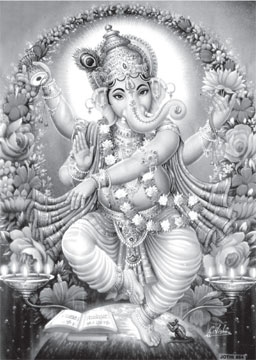Chariot festival reminds man to control his passions
by Chelvatamby Maniccavasagar
The Sri Sarwarjha Sidhi Vinayagar Temple situated at Modera is
dedicated to Lord Ganesha and its annual festival commenced with the
flag hoisting ceremony on August 24 and the chariot festival will take
place on September 1 and the water cutting ceremony will be on September
2. All the religious rituals will be performed during the festival by
the Chief Priest of the temple Sivagama Kiriya Yothi Shiva Shri
Somasundara Kurugal.
 The late S. Sellamuttu who was the former Mayor of Colombo, the late
A. Sinnathamby, Umesha Sellamuttu and Dr. A.S. Kunasingham were
responsible for the reconstruction and restoration of the temple which
was in a state of dilapidated condition. In 1992, a major repair was
done to the roof of the main Vinayagar temple. Even the Vasantha
Mandapam was redone and in 1993 Mahakumbabishekam was performed. The late S. Sellamuttu who was the former Mayor of Colombo, the late
A. Sinnathamby, Umesha Sellamuttu and Dr. A.S. Kunasingham were
responsible for the reconstruction and restoration of the temple which
was in a state of dilapidated condition. In 1992, a major repair was
done to the roof of the main Vinayagar temple. Even the Vasantha
Mandapam was redone and in 1993 Mahakumbabishekam was performed.
When Dr. A.S. Kunasingham became the trustee of the temple, he took
steps to give a new look to the temple. In 1994, the construction of the
Gopuram was completed and subsequently the Mahakumbabishekam was held on
June 10, 2005. The temple now has a magnificent look.
Sanctum
Every Hindu Temple has a Sanctum dedicated to Lord Ganesha. Hindus
make this first offering to Lord Ganesha in all ritualistic worship. Be
it pilgrimage, wedding, Yaga or House warming, Lord Ganesha is the first
deity to be worshipped at the beginning of any ceremony. Vinayaga,
Ganapathy, Vigneswara and Pillaiyar are some of the common appellations
given to Lord Ganesha, the god with an elephant head. The bulky body of
Lord Ganesha stands for the cosmos in its entirety. The huge belly
signifies space containing all things and beings in the world. The trunk
represents the sensitive reception of stimuli and cognition. It also
signifies the faculty of discrimination.
The broken tusk signifies that he has broken away from ignorance
which guides the path of God. The single tusk also denotes single
mindedness in actions. The other tusk indicates brighter knowledge.
A common form of worship of Lord Ganesha is rapping at the forehead
with knuckles and pulling earlobes with cross hands. This act helps in
the purification of the Naadis. The smashing of coconut shows that the
hard nut of ego should be cracked and get rid of before God and
subsequently prostrated for complete surrender. Further, the camphor
that is burnt in front of Lord Ganesha signifies that we have to burn
our illusion of ego with the fire of true knowledge and leave no residue
so that we may merge with God.
Body and soul
The Chariot or Ther symbolises human body and the statue of Lord
Ganesha is the soul. In front of the Chariot are the wooden horses
presenting in a galloping posture with the reins attached to their
mouths held in the hands of the image of Lord Ganesha. The horses
represent human fashions while the reins symbolises the necessity of
restraining and guiding these passions by the soul.
The journey of the Chariot through the streets is an emblem of the
progress of life. This shows that throughout his life, a man must
control and guide his passions. The passions are the motive power, the
driving force of life, but unrestrained and not properly guided, they
will wreck a man's life. This is the symbolic meaning of Chariot or Ther
festival.
|

